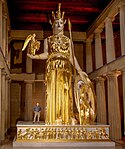Greekreligion-animalsacrifice-corinth-6C-BCE
The plaque represents a procession to an altar to sacrifice a lamb to the sound of the aulos and the lyre. Dedication to the Graces (Charites) is indicated with the names of Euthydika, Eukolis, Etheloncha and, on the side, the name of the painter, of which only the origin, Corinthian, still remains. c. 540-530 BC. National Archaeological Museum of Athens, No. 16,464."
Relevante Bilder
Relevante Artikel
ThysiaDie Thysia war das häufigste und verbreitetste Opfer in der griechischen Religion. Das Opfer wurde für Götter und Heroen ausgeübt. Es beinhaltete das teilweise Verbrennen der Opfergaben und das anschließende Opfermahl. Der Begriff ist seit dem Beginn des 6. Jahrhunderts v. Chr. überliefert. .. weiterlesen
Religion des antiken GriechenlandDie Religion des antiken Griechenland umfasst eine Reihe von Glaubensvorstellungen, Ritualen und Mythen, die ihren Ursprung in der griechischen Antike sowohl in der Form populärer Volksfrömmigkeit als auch offizieller Kultpraktiken haben. Viele Elemente dieser religiösen Bereiche fanden sich in analoger Ausprägung in der gesamten griechischen Welt wieder. Jedoch konnten hierbei erhebliche regionale Unterschiede auftreten. Daher ist es besser, von griechisch geprägten Lokalreligionen zu sprechen. .. weiterlesen
















